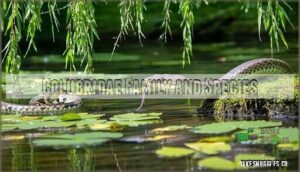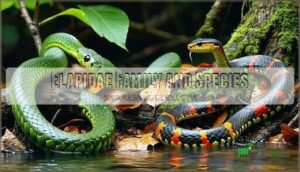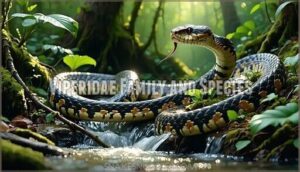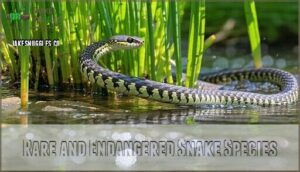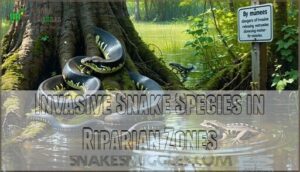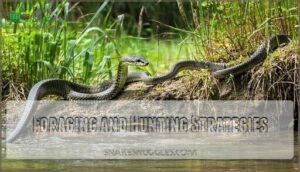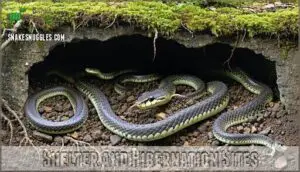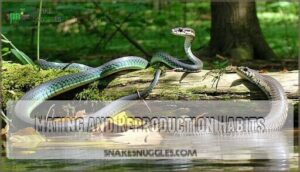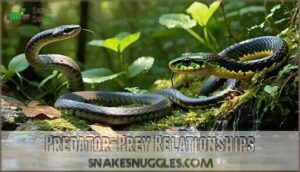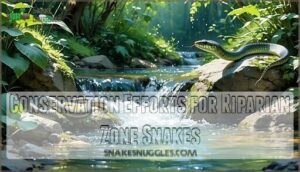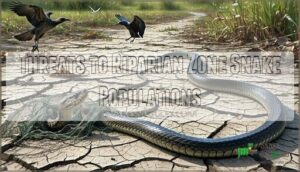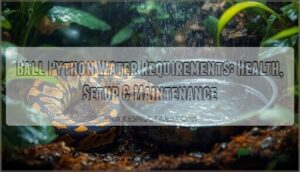This site is supported by our readers. We may earn a commission, at no cost to you, if you purchase through links.
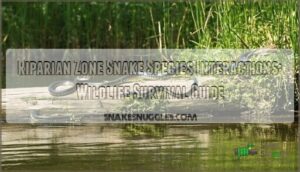
These serpents don’t just randomly slither around – they’re strategic operators.
Water snakes hunt fish and amphibians in streams, while terrestrial species like garter snakes patrol banks for rodents and insects.
They share basking spots on sunny logs and compete for prime hibernation sites under root systems.
Different species avoid direct competition through temporal hunting – some are active during dawn, others at dusk.
The moisture-rich environment supports higher prey density, creating snake hotspots where multiple species coexist.
Understanding these behavioral patterns reveals nature’s intricate balance system.
Table Of Contents
- Key Takeaways
- Riparian Zone Habitat Characteristics
- Snake Species Found in Riparian Zones
- Snake Behavior and Interactions in Riparian Zones
- Conservation Efforts for Riparian Zone Snakes
- Threats to Riparian Zone Snake Populations
- Frequently Asked Questions (FAQs)
- What species depend on riparian zones to live?
- Do snakes have social interactions?
- How do snakes respond to the environment?
- What snake species can be housed together?
- What are some species that depend on riparian zones?
- What animals are in the riparian forest?
- Why are riparian zones important to wildlife?
- What are the functions of riparian zones?
- How do snakes interact with other wildlife in riparian habitats?
- What are the unique challenges of studying snakes in riparian areas?
- Conclusion
Key Takeaways
- You’ll find riparian zones create strategic hunting grounds where water snakes target aquatic prey while terrestrial species patrol banks for rodents, reducing direct competition through temporal activity patterns and habitat partitioning.
- You can observe how snakes share critical resources like basking spots on sunny logs and hibernation sites under root systems, with some species returning to the same overwintering locations annually due to ideal thermal conditions.
- You’ll discover that riparian corridors support 60% of North American snake species through abundant prey, stable microclimates, and diverse habitat structures that provide everything from aquatic hunting grounds to terrestrial shelter sites.
- You need to understand that these ecosystems face mounting threats from habitat fragmentation, climate change, invasive species, and pollution that can devastate entire snake communities, making conservation efforts essential for maintaining ecological balance.
Riparian Zone Habitat Characteristics
Riparian zones create unique environments where water meets land, forming complex habitats that support diverse snake communities through varying moisture levels, temperature gradients, and abundant prey.
You’ll find these boundary areas offer everything from aquatic hunting grounds to terrestrial shelter sites, making them hotspots for snake species interactions and survival strategies, with diverse snake communities supported through the varying conditions.
Moisture and Temperature Regulation
Riparian zones’ temperature buffering creates perfect snake sanctuaries. You’ll find these areas maintain stable conditions that snakes desperately need for survival. Thermoregulation Strategies become effortless when snakes can move between sun-warmed rocks and cool, shaded banks. The Moisture Dependence of many species means they’re drawn to these humid corridors like magnets.
Riparian zones provide thermal refuges from climate extremes, offering moderate temperatures and high humidity for snakes. Smart Microhabitat Selection allows snakes to fine-tune their body temperature throughout the day. Behavioral Adaptations include shuttling between different thermal zones within yards of each other.
The Climate Sensitivity of reptiles makes these stable environments essential for their survival, especially as weather patterns become more unpredictable.
- Temperature varies less than 5°F daily in dense riparian vegetation
- Humidity stays 15-20% higher than surrounding uplands year-round
- Snake activity peaks when thermal conditions hit the sweet spot
- Behavioral thermoregulation requires minimal energy in these zones
- Climate change threatens these stable thermal refuges
Vegetation Types and Structures
You’ll find Plant Diversity thriving in riparian zones through distinct layers.
Canopy Structure creates a natural umbrella with willows and cottonwoods, while the understory houses shrubs and saplings.
Ground-level vegetation completes this Habitat Complexity.
Dense vegetation provides perfect snake hideouts, though Invasive Plants like Japanese knotweed can disrupt these carefully balanced communities.
This layered architecture offers Soil Stabilization through interconnected root systems.
Soil Composition and Fertility
You’ll discover that riparian zone soil composition creates the foundation for thriving snake habitat conservation.
This unique blend supports diverse riparian snake communities through specific characteristics:
- Soil texture ranges from sandy loams to silty clays, providing varied microhabitats
- Organic matter accumulates heavily, boosting soil fertility and supporting prey species
- Nutrient cycling accelerates through constant microbial activity and decomposition processes
- Erosion control strengthens as root systems stabilize banks and enhance water infiltration
Aquatic and Terrestrial Interface
The interface between water and land creates unique microhabitat use patterns where snakes capitalize on prey availability from both worlds.
Aquatic snake species like watersnakes exploit amphibian predation opportunities while terrestrial species hunt along water edges.
Floodplain dynamics reshape habitat connectivity, forcing snakes to adapt their movement patterns.
This interface supports diverse riparian snake communities through varied hunting grounds.
Snake species interactions intensify here as territories overlap.
Understanding these dynamics helps snake habitat conservation efforts protect critical riparian zone ecology features that sustain healthy populations.
Human Impact on Riparian Zones
Your backyard might seem peaceful, but human activity reshapes riparian zones in ways that dramatically affect aquatic snake species.
Development and agriculture create habitat fragmentation, breaking up continuous corridors these reptiles need for survival.
Pollution effects from runoff poison water sources while invasive species crowd out native vegetation.
Climate change alters flooding patterns, disrupting established riparian zone ecology.
However, smart riparian zone management and strong conservation policy can reverse habitat loss and restore these critical wildlife highways.
Snake Species Found in Riparian Zones
You’ll find three major snake families thriving in riparian zones, each with distinct characteristics that help them exploit different ecological niches along waterways.
Three distinct snake families master riparian zones through specialized hunting and survival strategies.
From the diverse non-venomous colubrids to the specialized venomous species, these reptiles have adapted remarkable strategies for surviving in these dynamic water-land boundary areas, using ecological niches to their advantage.
Colubridae Family and Species
You’ll encounter Colubridae snakes throughout riparian zones, where these non-venomous species thrive in diverse Colubrid Habitats.
Their Colubrid Diets include frogs, fish, and small mammals found near water.
Colubrid Behavior involves clever maneuvering between aquatic and terrestrial environments.
Colubrid Identification focuses on their varied patterns and sizes.
Colubrid Conservation efforts protect these adaptable hunters that maintain ecological balance through snake species interactions with prey availability in riparian zones.
Elapidae Family and Species
The Elapidae family brings serious firepower to riparian zones with their fixed front fangs and potent neurotoxins.
You’ll find these venomous predators thriving near water sources where prey abundance peaks.
- Elapidae Venom Composition: Neurotoxin effects rapidly immobilize prey through nerve disruption
- Mamba Behavior: Arboreal species ambush from riparian canopy positions above water
- Cobra Adaptations: Spitting species target predator eyes near exposed riverbanks
- Coral Snake Ecology: Texas coral snakes utilize riparian debris piles for shelter
These snakes inject venom via muscular gland contraction.
Viperidae Family and Species
You’ll encounter Viperidae family members wielding impressive venom potency throughout riparian corridors.
Pit vipers like copperheads excel at ambush hunting tactics, detecting warm-blooded prey with heat-sensing organs.
These venomous snakes target rodents, amphibians, and small mammals within dense vegetation.
Their medical significance demands respect—snake bites require immediate attention.
Conservation status varies, with timber rattlesnakes facing habitat pressures.
Understanding snake behavior helps you navigate their snake habitats safely while appreciating their role controlling snake prey populations in these essential ecosystems.
Rare and Endangered Snake Species
Several snake species in riparian zones face extinction due to habitat loss and population decline.
You’ll find these endangered snakes clinging to life in specific waterways, making their conservation efforts incredibly urgent for ecosystem balance.
Conservation strategies focus on protecting remaining populations through:
- Habitat preservation – Maintaining undisturbed riparian corridors for rare snake species like the narrow-headed garter snake
- Reintroduction programs – Boosting genetic diversity through carefully managed breeding initiatives
- Monitoring efforts – Tracking population trends to guide riparian snake conservation decisions
These efforts often include restoring riparian habitats to support snake populations.
These snake conservation efforts aren’t just about saving individual species—they’re about preserving nature’s delicate web of life.
Invasive Snake Species in Riparian Zones
Invasive species transform riparian zones into battlegrounds where non-native snakes wage war against local wildlife.
You’ll find Ecological Disruption peaks when Burmese pythons devour 80-100% of native mammals in Florida’s waterways.
Prey Competition intensifies as invasive watersnakes muscle out native garter snakes for food resources.
Control Methods like live trapping and rapid response teams offer hope, while Spread Prevention requires your vigilance in reporting sightings.
These Ecosystem Impacts ripple through food webs, demanding immediate action to preserve ecological balance in snake habitats.
Snake Behavior and Interactions in Riparian Zones
Understanding snake behavior in riparian zones helps you predict encounters and avoid potentially dangerous situations.
These dynamic ecosystems create complex interactions between different snake species as they compete for food, shelter, and territory along waterways.
Foraging and Hunting Strategies
Within riparian zones, you’ll observe two distinct foraging strategies among snakes.
Ambush predators like cottonmouths position themselves near water edges, waiting motionlessly for fish or frogs.
Meanwhile, active pursuit hunters such as racers patrol streambanks, using speed to catch fleeing rodent prey.
Prey selection varies with prey availability – garter snakes switch between hunting fish during spawning runs and terrestrial insects when aquatic food sources decline.
Shelter and Hibernation Sites
Once you’ve identified suitable foraging areas, selecting proper hibernacula location becomes your next priority for winter survival. Snakes can’t just pick any spot—they need specific thermal refugia that maintain stable temperatures above freezing.
Here are five key factors for ideal microhabitat selection:
- Rocky crevices or burrow types below the frost line
- South-facing slopes that capture maximum solar heat
- Well-drained sites preventing ice formation and flooding
- Dense root systems providing structural stability
- Proximity to hunting grounds for quick spring emergence.
Snake dens require precise microclimate conditions. You’ll notice den fidelity—many species return to the same overwinter survival sites annually. This behavior highlights how hibernation ecology depends on reliable shelter.
For superior construction, consider specific hibernacula building supplies. Without proper refugia, even healthy adults won’t survive harsh winters.
Mating and Reproduction Habits
Beyond hidden shelters, snakes enter mating seasons with elaborate courtship rituals. Males compete through combat dances and pheromone tracking to win mates.
| Species | Clutch Size | Nesting Ecology |
|---|---|---|
| Gartersnakes | 10-40 live young | Communal birthing sites |
| Ratsnakes | 6-24 eggs | Rotting logs, leaf litter |
| Watersnakes | 8-30 live young | Vegetation mats |
Reproductive success depends on ideal nesting conditions near water sources. Females carefully select laying eggs locations that provide moisture and protection. Most species offer minimal parental care, relying instead on strategic site selection.
Juvenile dispersal occurs rapidly after birth, with young snakes immediately seeking independent territories along riparian corridors. Snakes also use chemical signals during mating to attract partners.
Predator-Prey Relationships
You’ll find riparian zones teeming with predators and prey locked in nature’s endless dance.
Snake diet varies dramatically—gartersnakes target amphibians while ratsnakes prefer rodents.
Dietary overlap between species stays minimal, reducing competition.
Invasive crayfish disrupt traditional food chains, affecting prey abundance.
Meanwhile, nestling predation peaks near water edges.
Predator impact shapes the entire riparian zone ecosystem through cascading effects, influencing the delicate balance of the riparian zone ecosystem.
Human-Snake Conflicts in Riparian Zones
Human-snake conflicts in riparian zones often stem from habitat destruction and unexpected snake encounters.
You’ll reduce conflicts through effective yard management – keep grass short and remove brush piles where snakes shelter.
Fear mitigation starts with understanding snake behavior: they’re not aggressive, just defensive when surprised.
Most repellents efficacy is limited, so focus on coexistence strategies instead.
Practice snakebite prevention by wearing boots and watching where you step near water.
Remember, snakes control rodent populations naturally.
Conservation Efforts for Riparian Zone Snakes
You’ll find that protecting riparian snake populations requires a multi-faceted approach combining habitat restoration, targeted research, and community involvement.
These conservation strategies work together to address the unique challenges facing snake species that depend on these critical water-land interface zones for survival.
Habitat Restoration and Preservation
You’ll transform degraded riparian zones into thriving snake sanctuaries through targeted habitat restoration.
Restoration Techniques repair damaged ecosystems while addressing Habitat Fragmentation that isolates populations.
Smart planning creates effective Buffer Zones that protect waterways from surrounding disturbances.
Community Involvement strengthens conservation success through:
- Native vegetation planting along streambanks
- Invasive Species Control targeting problem plants
- Debris placement for snake shelter
- Monitoring water quality improvements
- Educational workshops for landowners
This ecological restoration rebuilds the foundation for healthy snake communities.
Effective restoration often requires specialized habitat restoration tools.
Species-Specific Conservation Plans
Today’s snake conservation demands Species-Specific Strategies designed to meet each species’ unique needs.
Effective conservation strategies combine targeted approaches with scientific rigor:
- Captive Breeding Programs maintain Genetic Diversity Management for endangered species like the giant garter snake
- Population Monitoring Techniques track recovery progress through systematic data collection
- Habitat Suitability Analysis identifies suitable sites for reintroduction efforts
These habitat preservation methods guarantee riparian zone ecosystems support healthy snake conservation outcomes.
Research and Monitoring Programs
Scientific research drives effective snake population monitoring in riparian habitats. You’ll find that systematic data collection reveals population trends, while habitat assessment identifies critical areas needing protection.
Population studies track species diversity changes over time, helping you understand snake community ecology dynamics. Addressing habitat degradation issues is critical for snake survival in these fragile ecosystems.
| Research Method | Conservation Impact |
|---|---|
| Mark-recapture studies | Population size estimates |
| Environmental DNA sampling | Species detection rates |
| Radio telemetry tracking | Habitat use patterns |
| Genetic research analysis | Population connectivity data |
These monitoring approaches provide the foundation for evidence-based conservation strategies that protect riparian snake habitats effectively, utilizing systematic data collection and habitat assessment to inform decision-making, ultimately supporting species diversity and population connectivity.
Community Engagement and Education
Building effective snake education programs requires hands-on community involvement.
You can educate neighbors through workshop demonstrations, teaching proper identification techniques and coexistence strategies.
Public awareness campaigns promote understanding and respect for riparian snakes.
Citizen science projects engage volunteers in data collection, strengthening conservation support.
Many resources offer specialized program materials for educators.
These responsible actions reduce harmful snake-human interactions while building appreciation for wildlife’s ecological value.
Policy and Legislation for Riparian Zone Protection
Effective riparian zone management requires strong policy frameworks that balance conservation with practical needs.
You’ll find success when these key elements work together:
- Buffer zone laws establish minimum distances between development and waterways
- Development restrictions limit construction in sensitive riparian corridors
- Grazing regulations control livestock access to prevent habitat degradation
- Water quality acts mandate pollution controls upstream from critical snake habitats
- Enforcement challenges require adequate funding and trained personnel for compliance
Wildlife law enforcement often struggles with limited resources, but habitat protection policies create lasting benefits for snake populations when properly implemented.
Threats to Riparian Zone Snake Populations
You’ll find that riparian snake populations face mounting pressures from both natural and human-caused threats that can devastate entire communities within these critical ecosystems.
Understanding these challenges helps you recognize why protecting these waterside habitats becomes essential for maintaining the delicate balance that allows diverse snake species to thrive alongside each other.
Habitat Destruction and Fragmentation
Habitat destruction tears apart riparian corridors, leaving snake populations stranded on ecological islands.
When you fragment these waterside zones, you create edge effects that expose snakes to predators and temperature extremes.
Limited movement between patches leads to genetic isolation, while reduced resources force snakes into unsuitable areas.
Corridor connectivity becomes essential for survival—without it, these specialized reptiles face local extinction despite conservation efforts.
Climate Change and Weather Patterns
Rising temperatures act like a thermostat gone haywire for riparian snakes.
Altered Hydrology from climate change disrupts their delicate balance. Extreme Events like floods and droughts force Habitat Shifts, while microclimate variation affects Snake Physiology.
Prey Availability fluctuates wildly during climate extremes. You’ll notice behavioral adaptations as these resilient creatures adjust their snake survival strategies to navigate increasingly unpredictable riparian conditions.
These snakes require abundant food and shelter to thrive in these areas.
Invasive Species and Disease
When invasive species infiltrate riparian zones, they disrupt local ecosystems through disease transmission and prey reduction. These unwelcome guests create ecological effects that challenge native snake populations through increased competition and habitat degradation.
- Invasive snakes like Burmese pythons devastate native prey, reducing food availability by up to 90%
- Disease transmission spreads Snake Fungal Disease through contaminated soil and direct contact between species
- Prey imbalance occurs when invasive crayfish and bullfrogs alter traditional food webs
- Competition increase forces native snakes to compete for limited resources and territory
- Conservation strategies focus on early detection, rapid response, and habitat restoration efforts
Human Activities and Disturbances
Development pressure transforms riparian zones into neighborhoods, while road construction creates deadly barriers for migrating snakes.
Habitat disturbance from recreational activities disrupts nesting sites and forces species relocation.
Agricultural runoff introduces chemicals that affect prey depletion through contaminated water sources.
Human activities fragment these habitat loss corridors, making survival increasingly difficult for vulnerable populations.
Pollution and Water Quality Issues
Frequently, pesticide runoff and agricultural waste contaminate riparian waters, creating toxic conditions for snakes.
Heavy metals from industrial discharge accumulate in prey species, while microplastic contamination disrupts food chains.
Poor water quality forces snakes to abandon prime hunting grounds along waterways.
Pollution in riparian zones degrades aquatic ecosystem health, reducing prey availability and threatening snake water quality needs for survival.
Frequently Asked Questions (FAQs)
What species depend on riparian zones to live?
You’ll find over 70 North American snake species using riparian corridors throughout their lives. Aquatic species like watersnakes and gartersnakes thrive here, with population densities 2-6 times higher than upland areas.
Do snakes have social interactions?
Like theater actors sharing a stage, you’ll find snakes occasionally crossing paths but rarely forming lasting social bonds.
Most species are solitary hunters, though some gather during mating seasons or share winter hibernation sites for warmth and protection.
How do snakes respond to the environment?
You’ll notice snakes respond to temperature changes by basking in sun or seeking shade.
They detect vibrations through ground contact, sense chemical cues with their tongues, and adjust behavior based on seasonal patterns and prey availability.
What snake species can be housed together?
You can’t house different snake species together safely. Each species has unique temperature, humidity, diet, and space requirements that conflict with others. Cohabitation causes stress, disease transmission, and potential cannibalism.
What are some species that depend on riparian zones?
You’ll discover many species that rely on riparian zones for survival.
Narrow-headed Gartersnakes, Northern Cottonmouths, and various Nerodia watersnakes thrive here.
These corridors support over seventy North American snake species throughout their lifecycles.
What animals are in the riparian forest?
Riparian forests pulse with life like nature’s highway system.
You’ll find diverse mammals including deer, raccoons, and beavers alongside numerous bird species like herons and kingfishers.
Amphibians, reptiles, and countless insects complete this vibrant ecosystem with diverse mammals.
Why are riparian zones important to wildlife?
You’ll find riparian zones serve as nature’s highways and hotels for wildlife. They provide water access, diverse food sources, shelter, and migration corridors while filtering pollutants and regulating temperatures.
What are the functions of riparian zones?
Like nature’s kidneys, riparian zones filter pollutants, stabilize soil, regulate water temperature, provide wildlife habitat, create migration corridors, cycle nutrients, prevent erosion, and sequester carbon for ecosystem health.
How do snakes interact with other wildlife in riparian habitats?
You’ll spot snakes hunting amphibians, fish, and rodents while avoiding larger predators like birds of prey. They compete with other species for food and shelter, creating complex ecological webs.
What are the unique challenges of studying snakes in riparian areas?
Just when you’re finally spotting that elusive gartersnake, flooding washes away your study site.
You’ll face unpredictable water levels, dense vegetation blocking visibility, and snakes’ secretive nature making consistent observations challenging.
Conclusion
Studies show that 60% of North American snake species utilize riparian corridors for critical life functions.
You’ve learned how riparian zone snake species interactions shape these vital ecosystems through strategic hunting, shared resources, and temporal activity patterns.
These water-edge environments support diverse serpent communities through abundant prey, ideal microclimates, and varied habitat structures.
By understanding these complex relationships, you’re better equipped to appreciate nature’s balance and support conservation efforts that protect both snakes and their riparian habitats for future generations.
- https://en.wikipedia.org/wiki/Riparian_zone
- https://www.nationalgeographic.org/encyclopedia/invasive-species/
- https://www.epa.gov/climate-change
- https://www.virginiaherpetologicalsociety.com/reptiles/snakes/index.html
- https://video.vt.edu/media/VMN+CE+WebinarA+Diversity+and+Natural+History+of+Virginia%27s+Snakes/1_fk7zqyt7

